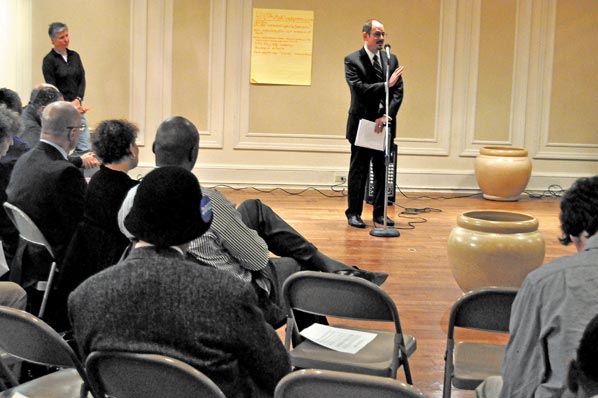Several-dozen LGBT and HIV/AIDS community leaders came together with city officials last week to discuss the local strategy to fight the epidemic.
The Feb. 22 meeting, organized by several community activists, was precipitated by community concerns following funding cuts in a recent Centers for Disease Control award administered by the city.
Among the topics discussed, representatives from the Health Department and the AIDS Activities Coordinating Office detailed the funding-award selection process for the recent High Impact HIV-Prevention Services awards, in particular the Resource Allocation Advisory Committee.
Created in 1993, the 12-member group assists in setting city HIV funding priorities and reviews funding applications, making recommendations to the health commissioner for his final approval.
The members, who are appointed by the commissioner, currently function in anonymity, which some attendees at the meeting took umbrage with, although health commissioner Donald Schwarz said that decision was made from past experience.
“When the RAAC was created, its membership was known and people heavily lobbied, so decision-making was not thought to have integrity by the community,” Schwarz said. “The RAAC reviews applications and ranks them, so it’s easy to see why that process should be unbiased. The decision was made that there would be confidentiality for RAAC members to maintain the integrity of the process.”
Schwarz, who spoke at the meeting, said that it is a “no-win situation” if the community feels that neither approach works, but the Health Department believes “the current process is working from the point of view of creating less bias in the process.”
This latest award cycle was redesigned to keep with the new national strategy on HIV/AIDS, which focuses more on identifying and connecting those who are HIV-positive to care, rather than concentrating on testing negatives — a departure from previous funding applications that some agencies asserted they weren’t prepared for.
Some attendees called for transparency in the applications the organizations submit for funding consideration, which contain numbers on their testing outcomes that are used to track the agencies’ progress.
Schwarz said not all AIDS services organizations agree about the release of these numbers, but the department is open to making them public.
“There’s a lot of dispute about the numbers,” he said. “While the Health Department would stand by the numbers, we’re always open to the idea that there could be issues with reporting. My understanding is that the provider community has felt strongly that the numbers could misrepresent them and, therefore, [have] not wanted that information to be public. But, if the community now wants that information to go to the public, the Health Department would certainly be willing to do that.”
While there were myriad issues that arose during the meeting, Terri Clark, Action AIDS prevention coordinator who helped facilitate the meeting along with organizers Kevin Trimmel Jones and Lee Carson, said the event was meant to serve as a building block for communication.
“It was an opportunity for the community to have its voice heard in terms of how they’re being affected by the epidemic, their ideas for prevention and for linking people to care, and for the Health Department to see how they can work more closely with the community,” she said.
Trimmel Jones said the event was a “great way for the community to come together with the Health Department to work on the common goal of ending HIV. It was a successful meeting in the sense that community members and the health commissioner were able to be in dialogue. It’s exciting to have the Health Department’s ear and attention to these matters, and we look forward to a working relationship with them.”
Trimmel Jones said there are still some “unanswered questions,” such as further specificity about the city’s strategy to end HIV and the role ASOs can play in that plan, as well as efforts to address cultural competency regarding black men who have sex with men with both HIV/AIDS organizations and broader health agencies.
Clark said there was a consensus among attendees that the community needs to hear directly from youth and from those in the mental-health and addiction-services circles.
She said forums geared toward those two communities are in the works, and city officials will again be invited to attend.
The epidemic’s effect on youth was addressed by numerous attendees, who noted that the recent upheaval in the School District of Philadelphia has stymied prevention efforts among students: A number of condom dispensers have been ordered and are currently sitting in a warehouse, awaiting district action to get the OK for them to be installed in city schools.
Schwarz said he is particularly interested in continuing conversations with young African-American MSM, a population the epidemic is most disproportionately affecting.
“There’s a need for ongoing dialogue between African-American MSM and the Health Department and service organizations,” he said. “That’s a really important issue right now. We welcome ideas on how best to engage this community, in particular young men of color. That’s something we’ve been trying to figure out how to best accomplish, and it’s a priority for the department.”
Jen Colletta can be reached at [email protected].

